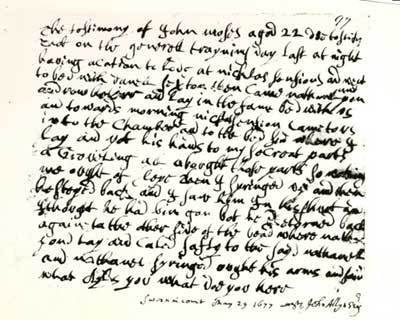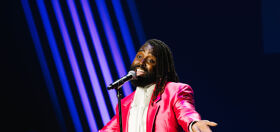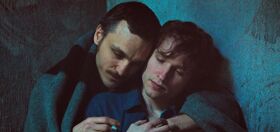
Before Thanksgiving was the capitalist celebration of crowded flights and family-related trauma that it is today, it was an opportunity for America’s power players to wine and dine with peace-loving people who they would later betray.
If that already sounds like your average Sunday drag brunch, then it might not surprise you to learn that there were most definitely queer people at that aforementioned first Thanksgiving.
So, yes, your first grade teacher was wrong. It was not “historically inaccurate” of you to dress up like that pilgrim lady in your school play. OK, OK, sorry, I’ve gone all “final episode of Drag Race” and started talking to my younger self again.
While it’s unclear from historical records whether or not there was a massive gay gang bang directly before or after the first Thanksgiving circa 1623, there were definitely plenty of twinks scattered around America at that time.
For starters, the Indigenous people themselves were already engaging in rigorous gender bending when Europe first started vomiting colonists onto their shores. This included the Wampanoag people, who appeared at that first Thanksgiving. And in the case of the Mamitarees, as the chummy, Brokeback Mountain-esque Lewis and Clark would later describe, some men could even marry other men.
While this pre-Western gender fluidity was a foreign concept to European visitors, it was not unimpactful on settlers. The results of this cultural overlap, propelled by that first Thanksgiving, cropped up almost immediately.
Over in Merrymount, a Massachusetts Pilgrim settlement, citizens were not just freely socializing with the indigenous Algonquin tribe, but freeing slaves for fun and, oh yeah, hosting Pride celebrations.
Well, sort of.
In one description of the settlement’s regular parties, Scarlet Letter scribe Nathaniel Hawthorne cited a “youth in glistening apparel, with a scarf of the rainbow pattern crosswise on his breast. … adorned with pink silk stockings.” During another party, the Merrymount revelers evocatively danced like “Ganymede” and “Zeus,” insinuating that this was a 17th century circuit party.
The best part, at least for America’s early dancing queens, was that no one cared too much. Non-procreative sex, though frowned upon, was usually not considered grounds for imprisonment or even the death penalty. In many cases, it simply resulted in a slap on the wrist, such as was the case for Nicholas Sension, who received a mere fine and public shaming after propositioning countless men between 1642 to 1672 in Connecticut.

Puritans, of course, would later appropriate the concept of sex from cool people and conflate it with religious duties, but for the first half of the 17th century at least, non-procreative sex was anyone’s game. That meant that massive Thanksgiving dinners could very easily have facilitated queer hookups.
There were many reasons for this sexual tolerance, and most of them had to do with the fact that life was already hard enough for America’s earliest settlers. They couldn’t go around executing queer people willy-nilly; they had a population to maintain. It was already miraculous enough that these queens had lived past 30. (In those times, queers didn’t experience “gay death” at 30; they literally just died.)
Still, at the end of the day, it was considered gauche to talk about gay stuff out loud – just like at modern-day Thanksgivings, when queers share dinner tables with their daffy, right-leaning Catholic aunts. It was for this reason that the earliest records of queerness have been relegated to sporadic criminal complaints.
In 1637, for instance, John Allexander and Thomas Roberts were charged with “lude behavior and uncleane carriage one w[ith] another, by often spendinge their seede one vpon another.” Sounds like your average Corbin Fisher video! Additionally, in 1629, a ship was reported as carrying “5 beastly Sodomitical boys [who] confessed their wickedness not to be named.”
Five beastly sodomites? Sounds like the dark room at Rockbar!
One exception to this rule involved the case of “Thomas-ine Hall,” a resident of early colonial Williamsburg, VA who alternately lived their life as a male “Thomas Hall” or female “Thomasine Hall,” depending on their mood. Thomas-ine was never accused of a crime, but was instead ordered to wear both men’s and women’s clothing after being discovered to be “both a man and a woman.” Looking back, it’s possible that Thomas-ine was intersex.
As we know now, all this revelry didn’t last forever. After religious and sexual conservatism swept America in the 17th and 18th centuries, homosexuality was eventually confined to underground gay bars similar to England’s 18th century “molly houses.”
In the meantime, however, queer people could still exchange winks and nods at Thanksgiving before traipsing off to the woods to bone. Plus, nothing could beat that First Thanksgiving in its implicit queerness. Merely by exposing the buttoned-up Pilgrims to the exotic gender fluidity of the Wampanoag natives, that meal subconsciously infected the European hets with an insatiable queer-curiosity that could only be satisfied later with things like “Ganymede-Zeus” dances. Is there anything queerer than that?
Related:
These “gay cousin at Thanksgiving” tweets serve up humor for the holiday
Yes, there is a “gay cousin prophecy” at work at Thanksgiving dinners—and in holiday TV movies—as these tweets attest.




















worship
Queerty cannot be trusted with historical information, East or West.
ShaverC
Agreed. To this publication, everything is/was/will be gay.
abfab
Then please find another source and STFU.
hung09uc
Did you happen to notice what the name of the site is? It’s rather clear from the title. You’re obviously reading so it should come as no surprise.
abfab
Puritans. Trolls. Straight. Republicans. He may read but not very well. Nothing really soaks in with ShaverC.
MISTERJETT
maybe you’d be happy visiting another site and staying away from this one. good luck with that, okay???
barryaksarben
LOL you straight jerks absolutely refuse to admit anyone anywhere enjoyed gay sex. Hate to break it to you but cowboys had a TON of gay sex so why not pilgrims. Attitudes have changed over and over but the only thing that stays the same is assholes like you denying our forefathers were getting busy with busy. Worship at your own damned church with all its lies
EdWoody
Can this site write a single sentence without reverting to gurlspeak?
bachy
Ha! Is that anything like Valley-gurlspeak?: “Like, then I’m all and then like she’s all, and I’m like, then she goes, and like I’m all . .”
barryaksarben
It is a gay site y’all. shave. you suck go try to get a girl already as if you ever could
barryaksarben
denigrating the feminine is soooo straight. gurls are beautiful and you are ugly go somewhere else if you are so afraid of feminine men
GlobeTrotter
I think we should be very careful about reading “queerness” into every historical event. Ideas such as “diversity”, “inclusion” or being “queer” would have been completely foreign to our ancestors from three to four centuries years ago. Of course there have always been individuals who expressed same-sex attractions and desires, but this didn’t make them “gender-fluid” or “queer” in a manner we would understand today, for the simple fact that such concepts hadn’t been invented yet. As for the Native Americans, many of their concepts of gender-fluidity were deeply tied to their religious practices, meaning that such individuals were seen more as priests or holy men/women rather than people living a certain lifestyle. Again, their concepts had very little to do with queerness as we understand it today.
As is usually the case with history, activists tend too often to project their ideologies onto peoples and cultures in the past as a way of lending legitimacy to their views. Problem is, our modern day concepts of homosexuality and queerness would have been completely foreign to anyone living before the 19th century.
abfab
”would have been completely foreign to our ancestors from three to four centuries years ”
Globe Trotter. You do not know this. Trott around the world some more and then get back to us. The Dutch and the Brits on The Gayflower we’re pretty Queer. Open your mind.
wikidBSTN
“gender fluid” and “queer” and “homosexual” are merely modern names to things that have always existed. They weren’t just discovered or “invented”. They already existed in the human condition – they were just given modern names.
abfab
Thank you wikidBSTN.
hung09uc
Perhaps for straights. I’m sure there were gays before the 19th century. The difference is that most of these folks had to repress who they were.. It’s not restricted to any century. I think you read a different article than I did. Nobody is trying to legitimize anything. The article merely states the obvious. There’s a reason why gay people had to run to the forest. They faced beatings and death. Despite the gains, gay people still face beatings and death.
GlobeTrotter
I see some of us here are so insecure that we’re desperate for any kind of affirmation of who we are, no matter how implausible or far removed from our present time. Another casualty of the tragic need for “representation” imposed on modern audiences.
Baron Wiseman
@GlobeTrotter
Well said, thank you.
MrMichaelJ
Do you mind citing your source maybe?
LGBT people have existed since Day One. The difference you are referring to is actually labeling it however things still exist even if you don’t stick a label on them.
GlobeTrotter
MrMichaelJ: My source is my degree in history and the many papers I’ve written on the subject. People having sex with the same gender have always existed in every culture, but LGBT, gender theory as well as homosexual rights/lifestyle are all thoroughly 19th and 20th century WESTERN inventions.
There are several examples I could cite to illustrate this point. In the Classical and Roman eras no one would have batted an eye if a man took a male lover, even while married to a woman. Why? 1. Marriages were mostly arranged, 2. Women had very few rights in comparison to men, 3. It was not expected for married couples to even love each other, your main task was to establish a family. If you were unhappy in your marriage to a woman, there was nothing wrong with looking for love from another man. Not so with women however! Having a male lover however resembled NOTHING like our modern concepts of homosexuality. As a rule the “pater familias” or male head of the household could NEVER EVER be the passive partner. The head of a the family assuming the passive role in sex would have been seen as an outrageous offence to good Roman morality. Passivity was seen as subordinate role reserved for women or other men of lower social standing, such as young men or slaves. Therefore a male head of the family could not initiate a same-sex relationship with his best friend with whom he was on equal social standing, for example. If he wanted a male lover, he would have had to take a man of lower rank, such as a slave or a young unmarried man. If you called such an individual at the time “homosexual” or “bisexual”, he would have had no idea what you’re talking about. Like I said, same-sex activity and attraction has ALWAYS existed, but they had almost nothing to do with our modern ideas.
Another case in point: in early medieval Europe, I believe from the 12th century (it’s been a while) we find a very interesting fine imposed by the courts in London. A certain woman was fined for prostitution, however after reading the opinion of the court it became clear she was not fined for being a prostitute, which was legal at the time, but for practicing prostitution OUTSIDE the designated zone in the city. Upon closer examination it was discovered that the “woman” in question was actually born a man. However the individual’s gender formed no part of the court’s reason for imposing the fine. She was simply fined and admonished by the court to only take on customers within the designated zone in future. I need not remind you that this was a DEEPLY conservative time in medieval history when the Catholic Church had a iron grip on society. Even sex between married couples was highly regulated by the church at this time (sex should only be done for procreation and NOT pleasure). However seeking the services of a prostitute, even a transgender prostitute, was perfectly legal at the time. Again, they had no concept of LGBT or gender theory. It was perfectly legal for a man to be married by day yet seek the services of a “transgender” prostitute by night. This didn’t make him “queer” or “bisexual” according to our modern understanding.
Let me stop right here, I could go on for several hours.
bachy
Appreciating your contributions to the discussion, Globe!
barryaksarben
It doesnt matter what the cultural difference were between then and now men were enjoying sodomy and oral. You can try to explain out away and make it out to a few outliers but it wasnt . It was as prevalent as it is today. How do you NOT understand in all those ages men and women were forced to hide their sexuality. jsut because no one recorded it (out of fear) does not mean it didnt exist in large numbers
abfab
And these horny little Pilgrams infected Native Tribes with every STD known to WASPS and Europeans.
All part of the genocide.
still_onthemark
Syphilis is native to the Americas, so they got us back with that one at least.
ShaverC
abfab, So what are you doing to to counter these atrocities?
Baron Wiseman
@ShaverC
Apparently, to counter the atrocities, he’s cutting and pasteing.
abfab
Grow up kids.
barryaksarben
IT was UNKNOWN to America until the europeons brought it. SO the guys enjoying their gay relationship whatever it looked like would know what we mean by homosexual? so what you are again on some level denying that there were sodomites ( a more timely name) always. You seem to try to deny that any of these were in any way romantic relationships. SO they had a different name for it again so what . How do you spend all that time studying gay history to deny it had anything to do with love or sex. You gone too far
abfab
THANKSGIVING Gay History: Gay Pilgrims In 1600’s Plymouth MA
November 23, 2022
In the summer of 1637, two working men at the English colony at Plymouth faced the possibility of execution if they were convicted of what the Puritans was said to be a grave moral crime.
Pilgrims John Alexander and Thomas Roberts had been caught in a homosexual relationship.
Plimoth Plantation Museum in Plymouth Massachusetts have discovered court records from their case, and from a handful of others to piece together the lives of the colony’s and America’s earliest gay and lesbian settlers.
“Plimoth Plantation as a museum has always been a place that has tried to recover every life,’’ said Richard Pickering, the museum’s deputy director. Pickering quoted the poet and author Paul Monette, who wrote that most of gay history “lies in shallow bachelors’ graves.’’
“We’re telling the audience that we’re going to talk about all those uncles and all those aunts who have fallen off the family tree,’’ said Pickering. “Their stories may be lost, so let’s contemplate those lost lives.’’ Though the historical record is sparse, “we can get a sense of what the options of the past were,’’ and provide some sense of history to a modern gay community “that really doesn’t have a strong sense of its past much before 1960.’’
Plimoth Plantation began researching the gay history of the colony about 15 years ago, in preparation for bringing its replica of the Pilgrim ship Mayflower to gay-friendly Provincetown.
Through the records were scant the prosecution of Alexander and Roberts for homosexual conduct reveals layers of complexities in the pilgrim life. Though the maximum penalty was death, neither man was executed. Alexander, who was perceived as the seducer and therefore was considered more responsible, was branded with a hot iron and banished from the colony, Roberts was allowed to stay, though the colony forbade him from owning land or participating in the political process.
“At first glance you would think that 17th-century New Englanders would be very harsh,’’ said Pickering. But both men were spared execution, and in time Roberts was allowed to own land and to vote. “Even though there are statutes, in the enactment of the law they are much more gentle.’’ It may have been that the colony needed every pair of hands and couldn’t afford to lose both workers, or that in a tiny community of a few hundred, the judges would have known the defendants personally and would have been reluctant to send neighbors to their deaths. (But some did try.)
Happy Thanksgiving
JC62
First of all, there is no proof per the title of this article that “Pilgrims had a ton of gay sex”. Just because there was one homosexual couple written about in the records going to court, it doesn’t mean there was a ton of gay sex. No proof of this and I just want to echo what others have said, as this is a badly written article.
abfab
Re write it. Add something. I’m sure your little article will be far more superior.
Man on man sex (oh dear, dare I say Gay sex) was a daily and nightly occurance. On the ship and off the ship. Don’t play games with us. The constant denial is lame.
barryaksarben
abaft is right. it was only one but that one tells us that sexual and ROMANTIC gay relationships were in the colonies and all this denial is pathetic in its attempts to deny our existence back then. we were e there ewe were queer or if you feel it is more appropriate we were sodomites get used to it
lbcandide
This was one of most absurd, nonsensical, and inaccurate articles I’ve seen on here, and that’s saying quite a lot. Gay sex was punishable by death under English law at that time. It was NOT Rome or Greece.
still_onthemark
Yes, it was always theoretically punishable by death IF the court decided on death. But they were more lenient in early New England, for many reasons that the article explains. These were short-handed communities living a precarious existence, very far from England. Work was never-ending and they needed every able-bodied male to help out, even if he was a “sodomite.” Queerty isn’t making up this stuff; I’ve read it elsewhere over the years.
Jaesly
I just have to laugh at the people complaining about how ahistorical this article is. Who comes to a website called Queerty looking for peer-reviewed historical research? I am beginning to suspect that just enjoy nitpicking.
lbcandide
So, we should expect no journalistic standards from these supposed journalists? If the readers don’t hold them accountable for producing garbage like this, who will in your view?
ShaverC
People expect even a small level of accuracy when writing thee stories. Queerty purposely tries to push a narrative that the world was free and gay up until recently, which isn’t the case.
abfab
Jaesly…..if nothing else, these two are laughable.
Please note that should a post by a Queerty editor be lacking and not up to your ”standards”, this could be your opportunity to reseach further, if you really cared. Can you do that?
barryaksarben
shaver c and his troll buddies try to insist that gay sex and romance didnt exist til when exactly? There have been gay or if you are so rigid “sodomites” sine the beginning of time and many had happy lives when left alone by the bigots who wouldn’t know it if you called them that term in every time period
tomamundo
Thank you abfab. You always make this worth reading!
abfab
Prego!
abfab
PBS
AMERICAN EXPERIENCE
”THE PILGRIMS” by RIC BURNS
——must see, compelling –some of us may have enjoyed this already—-highly recommended
AIRED NOVEMBER 19, 2020
The Pilgrims
Film Description
Arguably one of the most fateful and resonant events of the last half millennium, the Pilgrims journey west across the Atlantic in the early 17th century is a seminal, if often misunderstood episode of American and world history. The Pilgrims explores the forces, circumstances, personalities and events that converged to exile the English group in Holland and eventually propel their crossing to the New World; a story universally familiar in broad outline, but almost entirely unfamiliar to a general audience in its rich and compelling historical actuality.
RobF
How enlightening – just wanted I need this Thanksgiving!
inbama
Don’t be fooled by PBS.
Marsha P. Johnson was the first to set foot on Plymouth Rock – and in heels, yet.